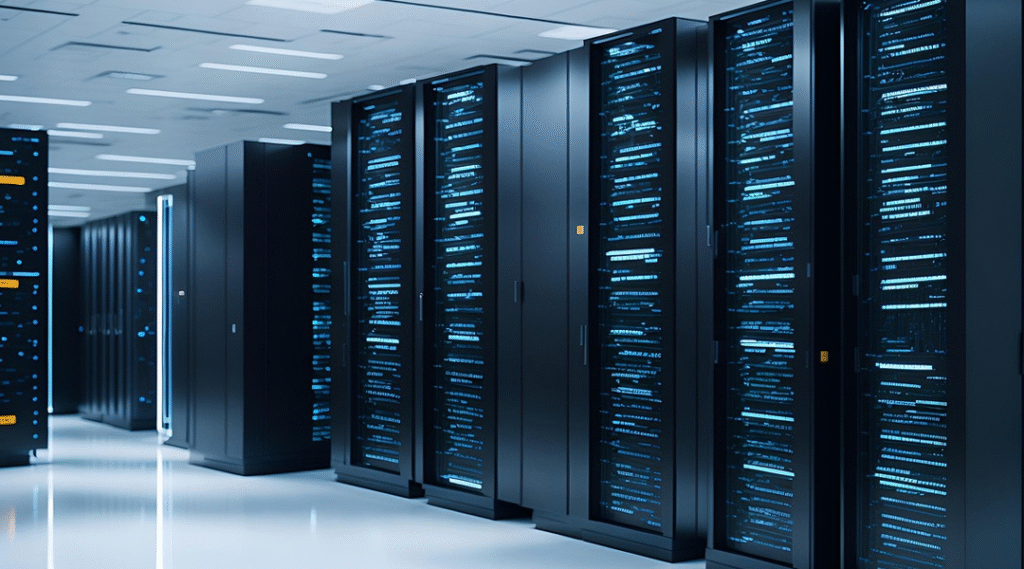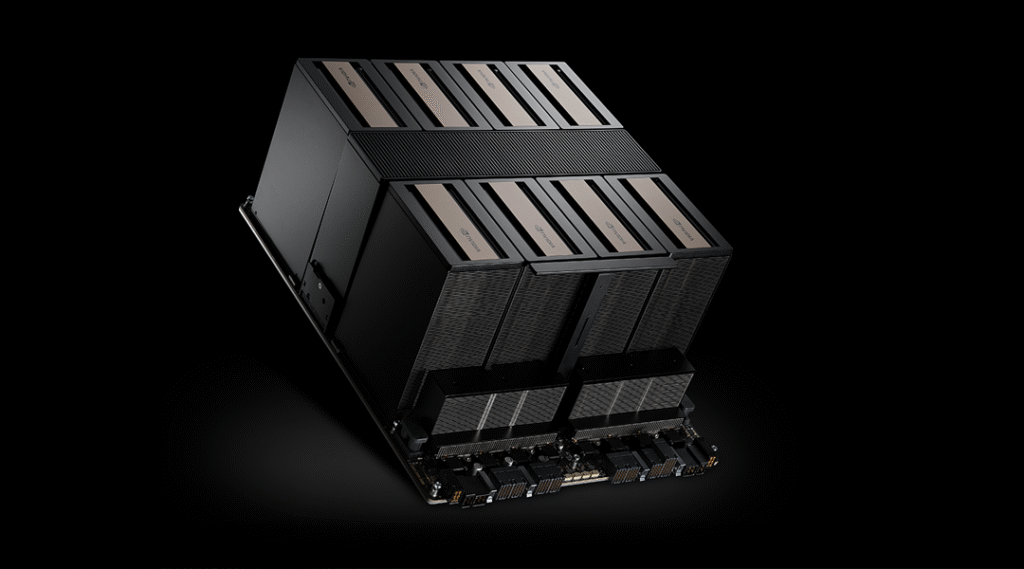NVIDIA’s HGX is billed as a “purpose-built” supercomputing platform for AI and HPC: a rack-scale reference architecture that pairs NVIDIA GPU accelerators with high-bandwidth NVLink/NVSwitch interconnects, InfiniBand networking and a software stack (CUDA, Magnum IO, DGX/HGX system designs) to deliver large-model training and inference at scale. But does HGX deliver measurable gains in performance and efficiency for real-world data centers — and how does it stack up against major alternatives such as AMD Instinct, Google TPUs, Intel’s Habana and Graphcore?
What HGX actually provides (key technical levers)
HGX is not a single chip but an integrated platform: modern HGX designs pair NVIDIA data-center GPUs (Hopper / Blackwell generations and their feature sets) with a rack-level NVLink fabric and NVSwitch to enable very high GPU-to-GPU bandwidth (NVIDIA markets NVLink Switch fabrics at ~1.8 TB/s per GPU pair in full-fabric configurations). HGX reference designs also emphasize Mellanox InfiniBand networking and software layers (Magnum IO, CUDA-X, libraries and orchestration) to keep data moving fast and to scale across hundreds or thousands of GPUs. These interconnect and software pieces are central to the platform’s ability to support very large LLM training and multi-GPU HPC jobs.
Real benefits: where HGX tends to help
- Throughput and scale for large models. The HGX design reduces communication bottlenecks between GPUs. For large language models and dense HPC workloads that require frequent all-reduce and large tensor exchanges, NVLink/NVSwitch + InfiniBand yields tangible speedups compared with loosely connected GPU clusters. NVIDIA also highlights Transformer Engine and FP8 support that can dramatically reduce training time for some LLMs. That matters when time-to-solution directly affects cost.
- Software and ecosystem productivity. The CUDA ecosystem, optimized libraries (cuDNN, NCCL), and NVIDIA system reference designs lower integration and tuning effort. For many teams the labor-savings and faster time-to-production are as important as raw flops.
- Operational predictability at scale. Because HGX is a validated reference (and used in DGX and OEM systems), operators can more easily plan cooling, power and scheduling for GPU-heavy workloads versus cobbling together heterogeneous servers with ad-hoc networking.
Where HGX is less dominant — alternatives that matter
HGX is strong, but competitors shine in different axes.
- AMD Instinct MI300 series (and MI300A APU): AMD’s MI300 family focuses on large memory capacity, new chiplet/APU packaging (integrating CPU and GPU dies), and dense HBM capacity for memory-heavy workloads. For data centers that prioritize high memory per accelerator and heterogeneous CPU-GPU integration (reducing CPU-to-GPU transfer overhead), AMD’s approach is compelling and has attracted major cloud and hyperscaler interest. In short: MI300 can be a superior fit for memory-bound models and workloads where CPU/GPU tight coupling matters.
- Google TPU v4 (and TPU pods): TPUs are ASICs optimized for matrix multiplication and scale very well at pod level. Google’s TPU v4 architecture emphasizes chip-to-chip optical/OCS fabrics and claims performance-and-performance-per-watt advantages at hyperscale; for organizations operating at pod/exascale levels, TPUs often beat GPUs on price/performance for some model classes — at the cost of less generality and dependence on Google Cloud.
- Intel Habana Gaudi2: Habana (Intel) targets training performance with large in-package HBM and a custom core design; Intel’s claims indicate high throughput across popular NLP and CV workloads, positioning Gaudi2 as a cost-efficient alternative for large training clusters when software and model support are in place. Gaudi2 emphasizes aggressive memory bandwidth per chip and competitive throughput vs older NVIDIA generations.
- Graphcore IPUs and other accelerators: IPUs adopt a different programming model (fine-grained model parallelism, large in-processor memory) and can be attractive for specialized research or inference patterns that benefit from low-latency tensor scheduling. Graphcore’s IPU-M systems target scale-out AI compute beyond GPU paradigms.
Practical tradeoffs & selection guidance
- Workload fit > peak FLOPS. If your workloads are diverse (training, inference, HPC, mixed precision), HGX’s software maturity and general-purpose GPU flexibility usually translate to better overall utilization. If you run a narrow, hyperscaler-scale LLM fleet or have access to TPU pods, ASICs or a tightly integrated AMD APU design may win on cost or power for specific models.
- Ecosystem & portability. NVIDIA’s broad toolchain reduces porting risk; TPUs, Gaudi and IPUs often require more engineering for parity. That engineering cost should be counted when comparing TCO.
- Operational scale and vendor relationships. Large hyperscalers often co-design systems (and may prefer TPUs or AMD for contractual or cost reasons). For on-prem or cloud-agnostic teams, HGX frequently offers the least friction.

Verdict — does HGX “really” help?
Yes — when your priority is maximizing throughput for large, communication-heavy training jobs and minimizing integration time. HGX’s high-bandwidth NVLink/NVSwitch fabric, combined with InfiniBand networking and a mature software stack, delivers measurable performance and efficiency gains for many data-center AI workloads. However, HGX is not always the cost-optimal or highest efficiency choice for every scenario: AMD’s MI300 family, Google’s TPU pods, Intel Habana and specialized IPUs each have domains where they match or exceed HGX on price/performance, memory capacity, or power for particular workloads. Choose HGX when you value ecosystem, flexibility, and validated rack-scale designs; evaluate alternatives when workload specificity, raw price/performance at hyperscale, or tight CPU/GPU memory integration are decisive.
More articles for the similar topic:
Can NVIDIA’s DGX Platform Keep Its Crown? Deep Analyses
AI Chip Battle Among NVIDIA, AMD, Intel and More Competitors
Decentralizing the Cloud: The Rise of Edge Computing and Micro Data Centers
Intelligent Data Center Management and Automation
The Future of Data Centers: Key Development Trends for the Next 5 to 10 Years
As for in-depth insight articles about AI tech, please visit our AI Tech Category here.
As for in-depth insight articles about Auto Tech, please visit our Auto Tech Category here.
As for in-depth insight articles about Smart IoT, please visit our Smart IoT Category here.
As for in-depth insight articles about Energy, please visit our Energy Category here.
If you want to save time for high-quality reading, please visit our Editors’ Pick here.



